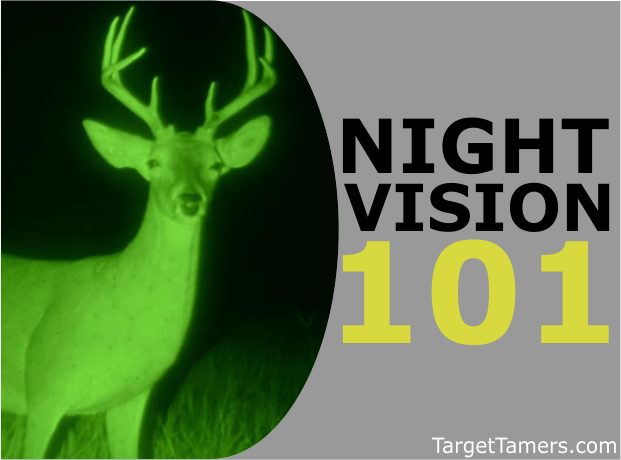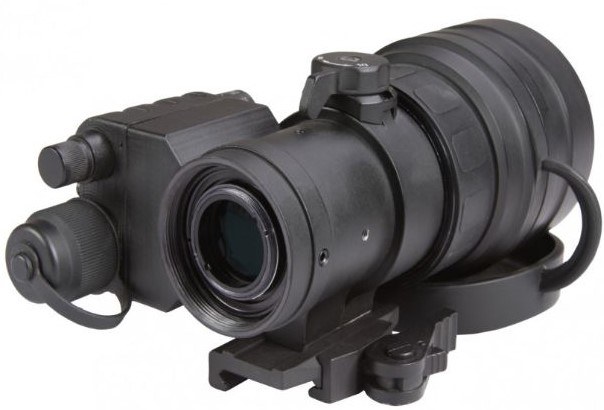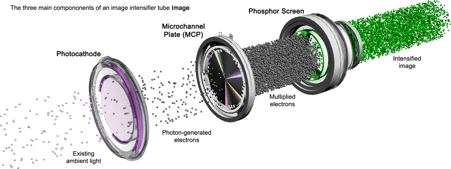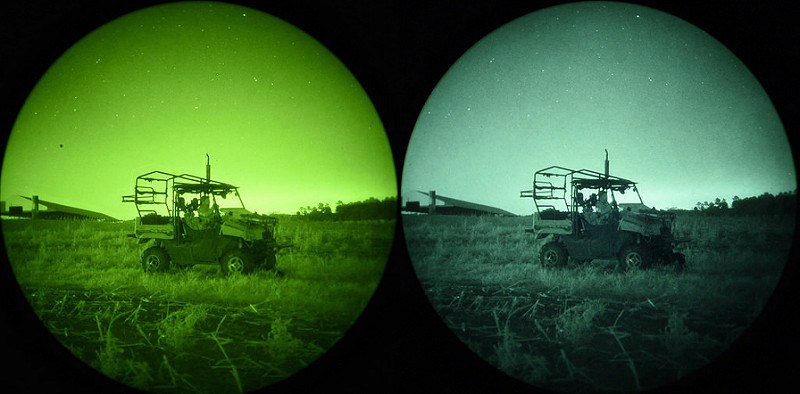
New to night vision optics?
Need to brush up on your night vision knowledge?
Perhaps, you're in the market for a low light champion that can transform the way you hunt at night?
We've got all the answers you need about night vision scopes and devices covered right here with the most common questions you're probably going to ask. Don't be caught out in the dark. Instead, be prepared for it and illuminate your mind!
Rifle Scope Night Vision FAQ's
1. Are Illuminated and Night Vision Scopes the same thing?
Illuminated scopes typically refer to the illuminated reticle within a rifle scope of which both night vision and non-night vision scopes have. While an illuminated reticle can help with low light hunting or seeing your cross hairs better in various lighting conditions, illuminated rifle scopes aren't the same type of optic as a night vision one. The differences lie in the scope tube and how it's made.
2. Who Needs a Night Vision Rifle Scope?
There are many purposes for a night vision scope. The first thought that comes to mind for most people is for military, law enforcement, and security/tactical uses.
When it relates to hunting, conventional deer, elk, and bear hunters who are legally limited to daylight hours may not find much use for a night vision scope. However, where certain types of varmint and hog hunting are allowed 24/7, a night vision scope would make all the difference with prey where spotlighting is ineffective and retards a productive hunt.
Within the U.S., you will have to check with your specific state's night hunting regulations to ensure you're lawfully hunting with the right equipment, on private/registered property, and to double-check if your state has night hunting season limitations.
3. What does I2 Mean in Night Vision?
I2 means "image intensifier." Image intensifier refers to the vacuum image intensifier tube that houses the photocathode, micro-channel plate, power supply, and phosphor screen.
4. How Far can Night Vision Scopes See?
This is a question that no one person can answer. The quality and generation of a night vision scope and the amount of light exposure in a particular environment have everything to do with a scope's detection and recognition range. A high-end Gen 3 scope with premium quality might be able to detect an animal or person at 300 yards away, but you mightn't be able to recognize or identify it as a specie or by gender until they're about 150 yards away.
When it comes to available ambient light, things can change again. If it's a really dark night, you'll have to get closer for to acquire positive detection and recognition ranges. If it's a bright night out, detection and recognition ranges can be further away.
5. Why are Night Vision Scope Images Green?
This explanation can get lengthy with cones, rods, eye biology, and chromaticity all thrown into the mix. The basic answer comes down to the fact that green is the color that is most sensitive and easily detected in various shades by the human eye because it's right in the middle of the color spectrum. Another theory is that moon and starlight emit wavelengths on the shorter side making for the green color an appropriate shade to detect, perceive, and interpret nighttime settings and terrain.
Another reason is because of the phosphor screen within the image intensification tube. Visible light in all its wavelengths enter the objective lens and through the tube as photons. Passing through the photocathode, they're converted to electrons. At this stage, wavelengths (color) hasn't been preserved. The electrons are then hurled towards the phosphor screen and the energy of the impact causes the phosphor to glow - a luminescence effect. Converting back into photons, you now have a green image of your target scene.
6. Is there Night Vision in Black and White?
Yes! This is new tech known as White Phosphor Technology (WPT). As you can tell, white phosphor is used versus the traditional green. You now have night vision in black and white. But, there's more to it than just the color of your target scene.
White phosphor screens are normally seen in upper Gen 3 scopes that typically have better quality and materials used to construct the night vision device. The result is superior image quality with a high degree of detail, resolution, and contrast than what a green phosphor image can provide. Even though human eyes are more sensitive to green hues, the unprecedented quality of WPT makes for fast target acquisition, positive identification, and a night-vision experience that can't be compared.
7. What are Filmless/Unfilmed Gen 3 Tubes?
Gen 3 scopes have an ion barrier film within the tube to improve the durability, robustness, and integrity of the device. In the '90s, the film was removed and dubbed as "Gen 4" tech, however, it was a failed class as it left the tube too fragile. Now, the tech has been perfected, and filmless and unfilmed night vision scopes are just as robust as ever.
The removal of the film also greatly improves resolution, sensitivity, and overall performance with less halo and blooming effects.
8. What is Signal-to-Noise Ratio in Night Vision?
The signal-to-noise ratio (SNR) is a factor that is very important when evaluating performance of a night-vision device. The value of the SNR indicates how sensitive a photocathode is, and consequently, how it affects the efficiency of the phosphor screen.
Put simply, SNR measures how much system "noise" interferes with the ability to have night vision in the dark. Evidently, it's a vital factor that interprets the overall performance of image intensification. A high SNR value indicates better resolution, contrast, and clarity. SNR values have been standardized, so it's safe to expect the same level of SNR quality among manufacturers. Look for a night vision device with a SNR value of a minimum of 21, and go higher if you can afford it.
9. What Does Autogating or Autogated Mean?
High-end Gen 3 night-vision scopes may have an auto-gated or pinnacle feature. This indicates the device's superior ability to function even under dynamic lighting conditions and during the day. The night vision device automatically and rapidly turns itself on and shuts off to constantly improve image quality.
Non-gated night vision scopes are susceptible to blooming, halo, and blurred image quality when artificial light is present. Also, non-gated scopes can be ruined by bright daylight.
10. What is Gain?
You might see this term associated with automatic gain or manual gain adjustment. Gain in and of itself relates to the clarity and brightness of an amplified image in a night vision scope. Users simply see this as somewhat of a brightness control. Each pixel within the field of view is intensified by voltage to produce an overall brighter image.
Scopes with automatic gain don't have the feature to manually adjust for differing lighting conditions. The night-vision scope will automatically adjust its gain to provide what it thinks is the best image quality for that light exposure in that environment.
However, a manual gain control can provide even finer adjustments for your image when you feel an image is over or underexposed. Manual gain is a premium feature.

11. What is Digital Night Vision?
This is a recent development in the night-vision industry. They're similar to night vision scopes as they provide the ability to see in the dark. However, a built-in chip and IR illuminator are used in a digital night vision scope. The chip amplifies light emitted by the IR and provides an image. Digital night vision monoculars and scopes can also provide real-time video recording, can be used in any lighting condition (day, night, dynamic conditions), and can offer various electronic features such as rangefinding, ballistic data, and more.
12. What is an IR Illuminator?
IR illuminators are typically built-in on a Gen 1 night vision scope, however, they can be built-in, mounted, or attached to aid higher-gen scopes. They emit and focus infrared light on the target scene to help the night vision device when there isn't enough ambient light available to produce an image. Infrared light can't be detected by the human eye, so it's invisible to detect. However, other night-vision users are able to detect you due to the IR illuminator.
13. Do I Need an IR Illuminator?
IR illuminators are detectable by other night vision devices, so they may not be the first option if being covert to other night vision users is of import. However, IR illuminators provide a supplementary light source in dark buildings, shaded areas, heavy timber, and anywhere when moon and starlight is unavailable.
14. Is Night Vision Gear Legal to Own?
Yes! It's absolutely legal to buy and own night-vision devices. However, certain restrictions are implemented when it comes to use of night vision gear for hunting. Each state within the United States has restrictions specific to night vision gear with a weapon. It's your responsibility as a consumer and user of a night vision device with a weapon to learn the laws and adhere to them.
15. Is it Illegal to take a Night Vision Device out of the United States?
This is a loaded question, and you will have to check with the manufacturer to stay in compliance with United States laws. There are many night vision scopes restricted from export, gifting, sales, and transfers to a foreign country outside of the United States or to a non-U.S. citizen. These night vision devices include Gen 2, Gen 2+, and Gen 3 and other variations. All exports of night vsion devices are controlled by the U.S. Department of State Office of Defense Trade Controls, and/or the U.S. Department of Commerce in accordance with the U.S. International Traffic in Arms Regulations (ITAR).
If you have a hunt coming up where you want to take your ITAR-controlled gear (including any weapons classified by ITAR, and also includes many night vision devices) with you outside of the country, you can apply for a temporary export permit stating details such as the country you're going to, what the night vision gear will be used for, and other specifics required to be granted the temporary export permit. Keep in mind, you will have to check into whether or not the country you may be visiting allows the import of ITAR-controlled gear. As an ITAR-controlled item requires a license for export, it may be best to get a licensed broker to help you through the process.
Know More Than You Did Before!
By now, some of your questions should've been answered. However, if you want more details, make sure to check out our "Understanding Night Vision Generations and Technologies" and "Night Vision vs Thermal Scope" articles.
If you've learned a little bit more than you knew before, then we've done our job. No question is a silly one when you don't know the answer!
Featured Image Source: atncorp.com
Further Reading





